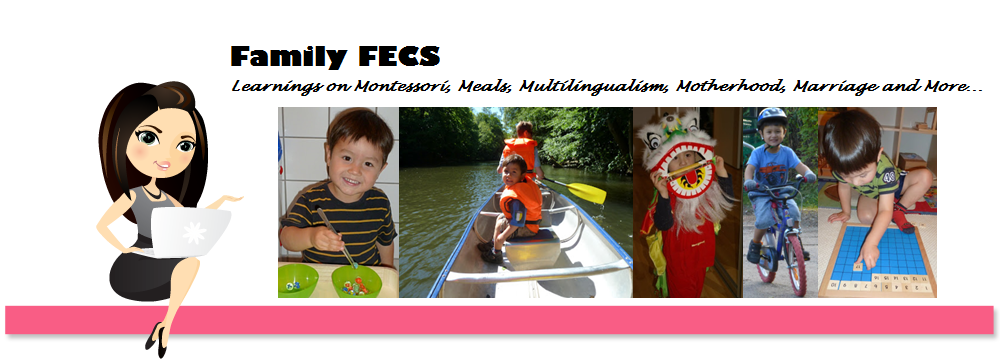Idea from Meixia
Age: From 2.5 years old
Activity Duration: 5 - 10 minutes
Objective(s):
1. To teach the concept of Chinese characters.
2. To teach reading
1. 1 container with old name cards
2. 1 marker
3. 1 tray
1. Ask your child what character he would like you to write.
2. Write it on the back of an old name card.
3. Teach using the Montessori 3 Period Lesson method:
- Step 1: Point to the Chinese character and read it to your child. For example, say "This is mom."
- Step 2: Say the Chinese character and ask your child to point it out. Example, "Show me the character 'mom'."
- Step 3: Point to the Chinese character and ask him what it is. For example, ask "What is this character?" Your child should say 'mom'.
If your child can't remember the Chinese character, you can use baby sign language to give him the hint.
My friend taught me this way of teaching Chinese to toddler. My friend's Meixia's son, Daniel is 2.5 years old (about 2.5 months younger than Joshua) and he can recognize 60 Chinese characters now. I thought that is really amazing.
Joshua (2Y8M25D) tried it today for the first time, and he enjoyed it quite a lot. He already asked me to set the tray nearby for another session tomorrow :-)
I found this method by my friend Meixia to be very simple, effective and also very inexpensive. What a better way to show Chinese characters than by writing it down yourself and show it to your child in real time. It is not necessary to buy expensive flash cards or DVD.
Don't show any picture with the character. I find showing picture to be a distraction to learning Chinese characters, as Joshua tended to look at the picture, and not the Chinese character. In this way, it really helped Joshua to only focus on the characters.
For younger children, keep it simple by limiting it to one-character word per card as shown above.
Yes, for the Europeans, this is a form of rote-learning. There is no other way of learning Chinese, except by rote learning. And it is amazing that toddlers like Daniel have such good memory. Incidentally, the characters are very intuitive, even for Joshua. For example, when I showed him the Chinese character for rain "雨", he pointed by himself to the rain drops in the character, before I could point out and explain it to him. And straight away he could remember and recognize the character for rain, when I showed him again.
Updates 3.12.2011:
Joshua (2Y8M28D) is very interested in reading, but does not seem to show any interest in recognizing Chinese characters. He is only interested in recognizing 4 characters - mom, dad and his name in Chinese. I showed him the character for mom and dad, and he asked me more than once for his name. So finally I wrote it for him. Now, he recognizes these 4 Chinese characters - 妈, 爸 and 慨恩.
References:
http://www.facebook.com/note.php?note_id=10150451140445091
http://www.words-chinese.com/symbols/_education.htm
